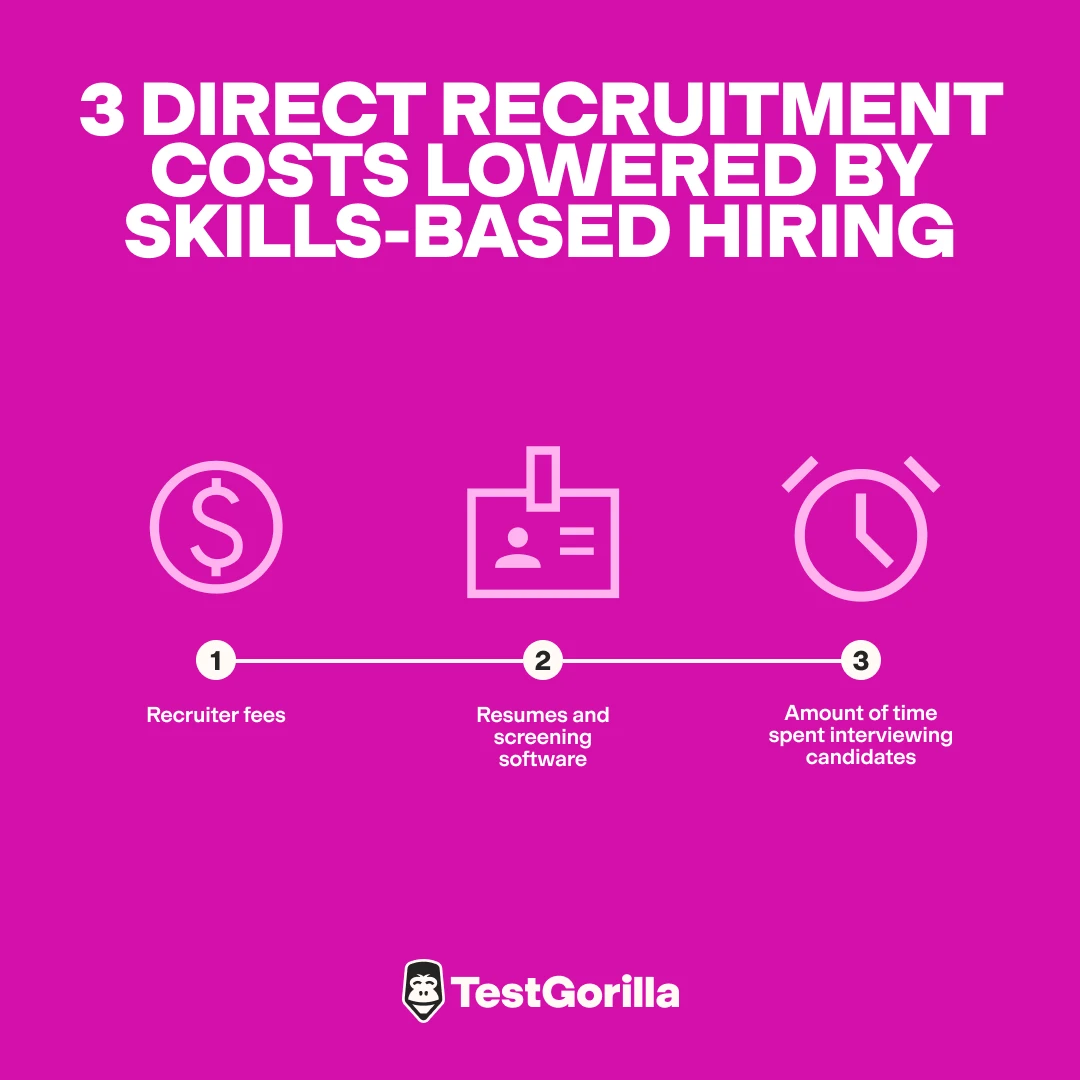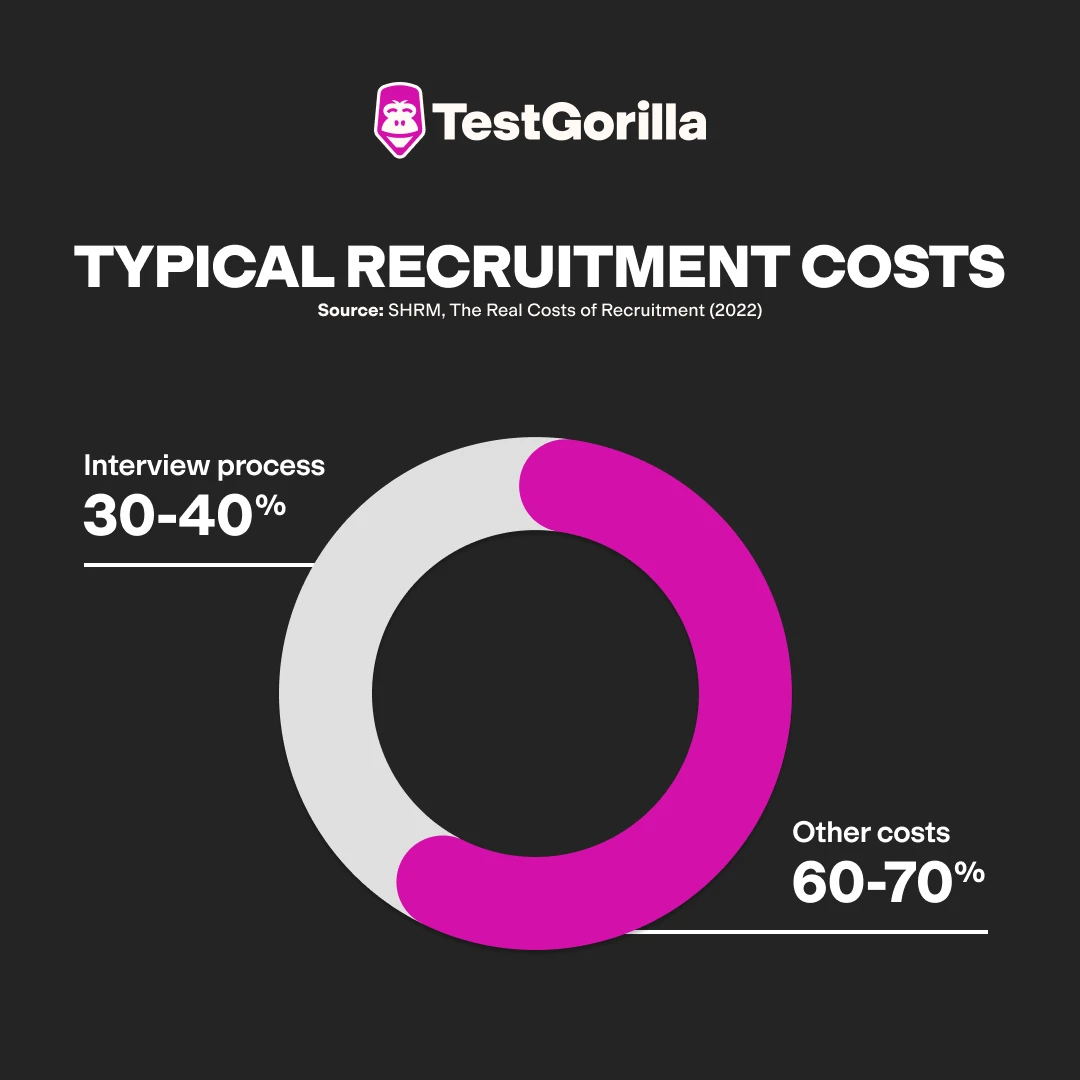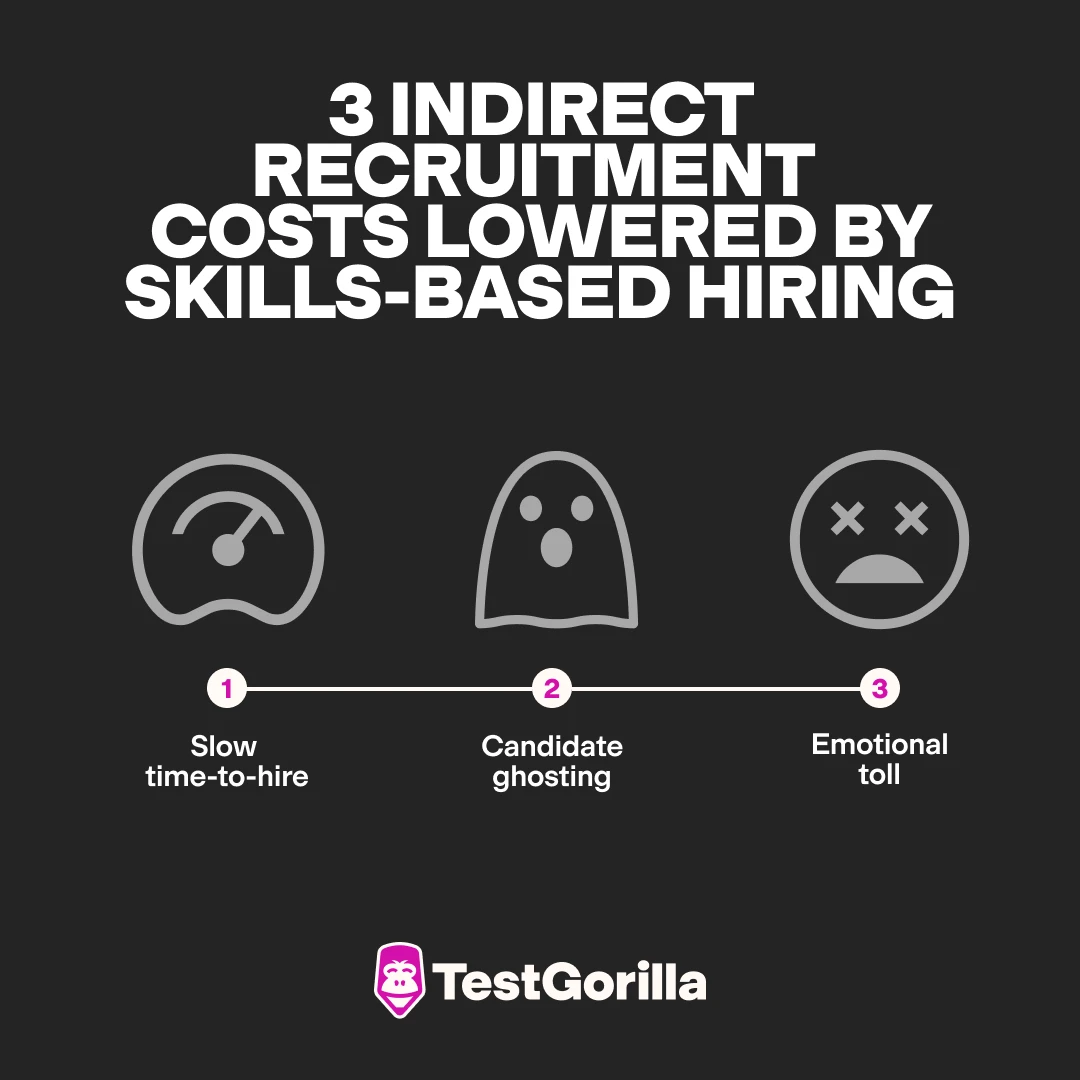Hiring costs add up very quickly if an efficient process is not in place.
Traditional hiring methods are bogged down with direct costs, like recruiter fees and the cost of resume screening software, in addition to several other indirect costs that lead to delays in time-to-hire, such as unstructured interviews and candidate ghosting.
These practices not only waste time, but they’re also not accurate predictors of a candidate’s future performance. They end up costing even more in the long run when employers have to rehire for the position.
Skills-based hiring cuts these costs down to the bare minimum, helping employers to identify top candidates without paying a small fortune in recruitment fees.
Our 2024 State of Skills-Based Hiring report found that 78% of employers using skills-based hiring reduce their total cost-to-hire.
Read on to learn about reducing hiring costs with skills-based hiring.
Table of contents
What makes hiring so expensive?
The cost of recruiting, hiring, and onboarding can run as high as $240,000 – and that’s just the monetary figure. The real cost of a bad hire extends beyond just a dollar sign.
A helpful way to understand exactly what makes hiring costs so high is to look at common direct and indirect recruitment costs that companies can take on. Direct recruitment costs can come from:
Resume-screening software
Paying a recruitment agency
Paying hiring managers
Any other cost that is closely related to a product, department, or project, like equipment, raw materials, or labor.
Indirect recruitment costs are a bit trickier to quantify, but some examples include**:**
Slow time-to-hire
Interview fatigue
Candidate ghosting
Recruiter pickiness
All of these recruitment costs drag down an organization’s bottom line. Let’s take a closer look at some of these common direct and indirect recruitment costs for employers, and the specific ways a skills-based hiring approach mitigates them.
3 direct recruitment costs lowered by skills-based hiring
If you dig deep enough into your hiring practices, you can uncover additional direct costs, from the coffee supplied at an in-person interview to recruiter training programs.
The following three direct recruitment costs are common across industries but are easily lowered by taking a skills-based hiring approach:
Direct recruitment cost | How skills-based hiring mitigates |
Recruiter fees | Bypasses inaccurate external recruiters in favor of internal HR teams who are familiar with your company’s goals and values |
Resume screening software | Shifts focus from experience listed on resumes to demonstrable skills on assessments |
Time spent interviewing | Minimizes bias and streamlines the interview process using a structured interview approach |
Let’s take a closer look at how skills-based hiring makes that possible.
1. Recruiter fees
Although outsourcing your hiring efforts to recruitment agencies saves your own employees time in the short term, most employers pay a commission of 15-25% when they hire a recruiter’s candidate.
What is troubling about this percentage is that companies are typically paying more for less information about a candidate’s actual skills.
The truth about recruiters is that they are not experts on what the job opening’s responsibilities are or what specific skills are required to thrive in the position. They usually don’t test candidates for skills either. This increases a company’s risk of hiring a candidate who is ill-equipped for the role.
Additionally, recruiters are typically unfamiliar with a company’s unique culture and typically settle for a “culture fit” approach rather than a “culture add.” Recommending candidates that add nothing to the existing culture increases unconscious bias and decreases diversity.
While consensus can be valuable in making decisions quickly, hiring candidates to increase consensus within a team can ignore strategic blindspots. If the group dynamic rarely challenges the status quo, companies lose money by:
Continuing to invest in failed products or services because you have already invested in the past (the sunk cost fallacy)
Missing out on the benefits of innovation: A global survey by Boston Consulting Group found that more diverse companies reported 19% higher revenues on average[1]
Lacking adaptability due to fixed mindsets, leading to poorer responses to challenges that can end up increasing losses and costs
Skills-based hiring bypasses recruiter fees and the added costs of a culture fit approach by:
Using skills tests to measure a candidate’s hard skills in specific areas that are directly related to the job
Using paid trials to give candidates the opportunity to do the actual work instead of relying on what recruiters tell them about the work
Using soft skill and culture add tests to hire candidates who are not afraid to challenge the status quo, increasing innovation and avoiding strategic blindspots that have financial consequences
2. Resumes and screening software
Resumes are proven to be unreliable predictors of job outcomes because they downplay a candidate’s skill gaps and overemphasize education and experience.
They’re also difficult to assess objectively. A mediocre resume may be treated as a top contender when reviewed after a poorly written one, for example. Additionally, employers often automate their resume screening process by paying for software that screens candidates based on keywords or answers to particular questions. This often leads to bias.
51% of employers say they struggle to determine whether the resumes of their applicants are accurate. Source: The State of Skills-Based Hiring 2023
The State of Skills-Based Hiring 2024
Read TestGorilla's annual report to discover why over 81% of companies are choosing to adopt skills-based hiring methods in 2024.
Freeing up HR to focus on important tasks other than sifting through piles of resumes seems like an efficient hiring strategy. But resume screening software has its downsides too:
Applicant tracking systems often exclude candidates with irregularities on their resumes, like a gap in employment, for example
They exclude candidates who do not have enough keywords and encourage candidates to keyword-stuff their resumes
Candidates can use strategies to trick the software into ranking their resumes higher
Investing in software that weeds out skilled candidates for arbitrary reasons while inadvertently encouraging other candidates to cheat the system is a waste of company time and money.
Skills-based hiring eliminates these costs by conducting a talent assessment first: skills and behavior are evaluated accurately, rather than a candidate’s ability to fit keywords into a document. As a result, skills-based hiring finds better candidates who have proven their abilities.
98% of employers agree or strongly agree that skills-based hiring is more effective at identifying talented candidates than resumes. Source: The State of Skills-Based Hiring 2024
3. Amount of time spent interviewing candidates
A research report by Glassdoor measuring global hiring trends during the first half of 2017, found that the interview process, on average, takes around 23.7 days.[2]
Depending on who is leading the interview process, departmental leaders and hiring managers spending that time searching for candidates can account for 30-40% of overall recruitment costs. So, traditional hiring methods that rely heavily on interviews are time-consuming, expensive, and tedious for HR and hiring managers.
But are interviews even worth it? It depends on how and why you are interviewing in the first place.
Unstructured interviews – interviews that are free-flowing without any predetermined metrics in place – consistently display lower reliability and validity than structured interviews. With the absence of any skill or behavior-oriented questions, unstructured interviews can also cause the interviewer to lead with their gut, instead of assessing the candidate’s abilities.
Instead, skills-based hiring incorporates structured interviews that ask pre-established interview questions where answers can be assessed and graded in a system you’ve already created. They’re one of the best predictors of job performance, especially when coupled with a skills assessment, work sample, or other job-relevant methods.
But how do they lower costs? Structured interviews lower costs by:
Avoiding freestyle interviews that take too long and don’t discern candidate skills, by asking specific behavioral and situational questions that focus on core competencies of the role
Eliminating time-consuming questions about previous experience, education history, where the candidate grew up, etc., in favor of questions related to current skills.
Reducing the time it takes to assess candidates post-interview because questions are the same for each candidate
Eliminating bias and the costs associated with it (groupthink, hiring unskilled workers) by asking candidates the same questions in the same order
Minimizing time spent hiring and training the wrong candidates by accurately predicting a candidate’s job performance
Interviews are a valuable tool for hiring managers to gain deeper insight into candidates’ skills and behavior, but the wrong approach can lead to a drawn-out, inefficient interview process that increases hiring costs.
3 indirect recruitment costs lowered by skills-based hiring
According to Edie Goldberg, founder of E.L. Goldberg and Associates, a California-based talent management company, around 60% of the costs related to a new hire are indirect costs.[3]
Indirect costs can be the time departmental leaders spend supporting screeners through outdated hiring practices, like what to look for in a good resume, or showing screeners how to spot a good cover letter, an equally poor predictor of job performance.
Let’s take a closer look at these three indirect recruitment costs that skills-based hiring avoids:
Indirect recruitment cost | How skills-based hiring helps |
Slow time-to-hire | Implements skills tests and paid trials to reveal the most skilled candidates and eliminate recruiter pickiness |
Candidate ghosting | Minimizes candidate ghosting due to interview fatigue by replacing interview rounds with pre-employment tests |
Emotional toll | Relieves hiring managers from stressful, time-consuming tasks, like resume and cover letter scanning, to increase job performance and satisfaction |
Folding these demands into existing job responsibilities can increase the workload at many different levels of a business, and can be hard to measure in dollars and cents without precise hiring metrics.
With a skills-based hiring approach, these costs are lowered by removing the steps that make them seem necessary in the first place.
1. Slow time-to-hire
Many factors can cause slow time-to-hire, from disorganized recruiters to a shortage of talent. But John Sullivan, an HR Thought Leader, argues that shifting to a data-driven approach to hiring that focuses on reducing time-to-hire is crucial to an employee and company’s success.[4]
Once candidates enter the labor market, time is of the essence. Research shows that most of the top talent is gone within ten days of entering the labor market.
According to John, very few firms have calculated the million-dollar consequences that result from companies not making offers in that period. These costs come from bidding on top candidates who have already been approached by competitors, leaving latecomers with hefty offers to make if they really want talent.
So what’s slowing companies down?
Time spent coordinating interviews with recruiters
Delays caused by inefficient communication between recruiters, clients, and HR staff
Taking too long to shortlist candidates because of internal debate
Hiring managers being too picky once they have talent in front of them
Data shows that pickier hiring managers do not pick better performers while leaving a greater number of positions unfilled for longer. The result: Each unfilled position in the firm they worked with cost the company more than $100,000 in margins.
Sure, defensive hiring practices can occasionally help you avoid a bad hire, but usually, the marginal benefit is not worth it. Skills assessments, paid trials, and structured interviews leave no room for pickiness. These strategies are driven by skills and performance data, helping hiring managers identify the right choice and fill costly job openings quickly.
The evidence is clear: In our State of Skills-Based Hiring Report for 2024, 81% of employers reported a reduction in their total time-to-hire when using skills-based hiring, while 16% saw a fall of more than half.
2. Candidate ghosting: A case study
Slow time-to-hire can have another costly outcome: candidate ghosting.
A survey from the global staffing firm, Robert Half, shows that 62% of professionals in the US say they lose interest in a job opening if they don’t hear back from the employer within two weeks (or 10 business days) following the initial interview.
If they don’t receive a timely response, job seekers are going to jump ship on a position. Candidate ghosting results from a hiring process that strings candidates along with exorbitant rounds of interviews, causing interview fatigue and resentment from the candidates.
The survey from Robert Half also shows that 26% of respondents said they would leave negative comments on review sites about lengthy and vague interview processes, which could potentially harm a company’s ability to attract future talent.
As we have seen, multiple rounds of unstructured interviews can cost employers who have to compensate the interviewers for their time and effort, but employers are also paying the price of losing out on skilled candidates who become fed up with the process.
For a real-life example, consider Mike Conley, a software engineering manager from Indiana who lost his job during the pandemic. He posted about his experience online, receiving more than two million views and nearly 4,000 public comments of support.
Dragging candidates through endless interview cycles, only to cut the cord when it’s time to make a decision, leaves positions unfilled and your talent pool frustrated. According to Google, four interviews are enough to predict a candidate’s performance with 86% confidence.[5]
A skills-based hiring approach removes this indirect cost by limiting interviews whenever possible in favor of pre-employment tests and skills assessments.
3. Emotional toll
This whole process takes an emotional toll on your hiring managers, too. According to Sharon DeLay, founder of GO-HR, demands for higher compensation, time off, perks, and flexible work schedules are an emotional burden to hiring managers.
Grappling with a shortage of talent, candidate ghosting, and going back and forth on whether to hire a certain candidate all put extra stress on hiring managers. This mental toll, according to Sharon, has financial implications as well, because hiring managers can lose focus on other duties or make poor hiring decisions.
Hiring managers are a crucial piece of any thriving business. Making sure they are supported just as much as the employees they are hiring is a must. Skills-based hiring lightens their load while increasing their flexibility and autonomy in the workplace, which impacts job satisfaction.
But what are the key factors affecting employee satisfaction, and how can skills-based hiring help with the emotional toll of hiring?
Factors affecting hiring manager satisfaction | How skills-based hiring helps |
Company culture | Ensures that employees, including hiring managers, feel that they can add to the existing culture and challenge the status quo whenever necessary |
Career opportunities | Gives employees an opportunity to learn, grow and achieve their career goals, through training and upskilling |
Senior leadership | Promotes leaders that support their employees instead of stifle them |
Work-life balance | Maintains this balance for hiring managers by taking unnecessary tasks off their plate |
Business outlook | Considers the future of an organization by hiring candidates that have skills, are willing to learn new skills, and can expand the existing culture to increase innovation |
When hiring managers spend less time on stressful, unproductive tasks, they can spend more time finding candidates who have the right skills for a position and constructing a diverse group of talented workers.
Additional hiring costs
The following hiring costs can be a combination of direct factors, like the cost of a bad hire, and indirect factors, like the effect on brand identity:
Additional hiring cost | How skills-based hiring helps |
Mis-hires | Implements role-specific assessments and behavioral interviews to ensure that the candidate knows how to do the job and can behave professionally |
Voluntary turnover | Increases diversity in hiring and offer opportunities to upskill to decrease voluntary turnover |
According to the Center for American Progress, replacing an employee, whether they were fired or left voluntarily, can cost anywhere from thousands of dollars to hundreds of thousands of dollars.
Adopting a skills-based hiring approach helps address the factors that contribute to mis-hires and voluntary turnover (and in some cases, these can overlap), keeping the costs of employee turnover low.
1. Mis-hires
Nearly three-quarters of employers admit they have hired the wrong person for a position, a staggering figure when considering the direct and indirect costs at stake.[6]
Replacing highly-paid candidates might cost employers more, but replacing lower-income employees still takes its toll. A candidate may look good on paper, but they may be resistant to change, a drag on morale, or incapable of learning new skills – these all contribute to costs.
Skills-based hiring has proven to prevent the cost of mis-hires. Our report, The State of Skills-Based Hiring 2023, shows that 82% of companies using skills-based hiring reduce mis-hires.
In addition to the loss of time and money spent finding, interviewing, and training a mis-hire, there are lost productivity costs such as:
Fewer team members to complete tasks and advance goals
Poor employee performance due to heightened stress and responsibility
Damaged morale due to mis-hire’s negative impacts on company culture
A skills-based hiring approach avoids these costs and prevents other horror stories, by:
Implementing skills tests to determine whether or not the candidate has the skills they say they do. In the junior accountant’s case, the employer could have used the Advanced Accounting test.
Asking behavioral and situational questions to evaluate their interpersonal skills, motivations, and reasons for acting a certain way.
Listening to the team that will end up working directly with the new hire to gain insight into what skills are needed to succeed in the role.
Mis-hiring causes ripple effects that can impact other areas of your business in unexpected ways. Skills-based hiring takes these risks into account and gives you the tools to prevent mis-hiring from happening in the first place.
2. Voluntary turnover
When skilled candidates head for the door, it costs a business more than just the price of replacing them. There’s the sunk cost of finding them initially in addition to the cost of training them, too.
For example, a company with 100 employees that pays an average salary of $50,000 could pay approximately $660,000 to $2.6m per year in replacement costs from voluntary turnover alone
Luckily, there are several ways to lower voluntary turnover.
Engaging with a diverse range of candidates and offering an inclusive work environment prevents employees from self-selecting out of the hiring process to search for a better fit somewhere else.
Skills-based hiring strategies can add to culture as opposed to homogenizing it with tools like TestGorilla’s Culture Add test, which sets the standard for company culture through a questionnaire you complete and then uses the same instrument to measure how your candidate lines up.
Offering employees a developmental career path can also keep voluntary turnover low, increasing employee engagement and team morale. If employees feel they have an opportunity to grow within a company, they are more likely to stay.
The data supports this: 74% of Millennial and Gen Z employees say they are likely to quit within the next year due to a lack of skills development opportunities.[7]
Skills-based hiring doesn’t just mean hiring candidates that have a finite amount of skills. It means hiring skilled candidates who have the potential to develop their abilities through upskilling and employer support, which can increase employee retention and lower costs.
74% of companies that use skills-based hiring lower their hiring costs. Want to join them?
Skills-based hiring is an approach that has proven to increase hiring speeds, accurately predict employee performance, and significantly lower direct hiring costs such as:
Recruiter fees
Resume-screening software
Time spent in interviews
And indirect hiring costs like:
Slow time-to-hire
Candidate ghosting
The emotional toll on hiring managers and other employees
Gray area costs (mis-hires, voluntary turnover)
Having a clear understanding of what exactly makes hiring expensive and eliminating outdated and costly hiring strategies can increase a company’s bottom line. Sign up with TestGorilla for free to give skills-based hiring a try and see the benefits yourself.
Sources
Lorenzo, Rocío, et al. (January 23, 2018). “How Diverse Leadership Teams Boost Innovation”. Boston Consulting Group. Retrieved April 3rd, 2023. https://www.bcg.com/publications/2018/how-diverse-leadership-teams-boost-innovation
Dr. Chamberlain, Andrew (August 9, 2017). “How Long Does it Take to Hire? Interview Duration in 25 Countries”. Glassdoor. Retrieved March 20th, 2023. https://www.glassdoor.com/research/time-to-hire-in-25-countries/
Lynch Jr., Orville. (July 23, 2022). “The Real Costs Of Recruitment”. Career Town. Retrieved March 20th, 2023.
Dr. Sullivan, John. (February 15, 2016). “Top Candidates Are Gone Within 10 Days… So Assign Each a ‘Hire-By-Date’”. ERE. Retrieved March 20th, 2023. https://www.ere.net/top-candidates-are-gone-within-10-days-so-assign-each-a-hire-by-date/
Shaper, Shannon. (April 4, 2017). “How many interviews does it take to hire a Googler?”. re:Work with Google. Retrieved March 20th, 2023. https://rework.withgoogle.com/blog/google-rule-of-four/
“Nearly Three in Four Employers Affected by a Bad Hire, According to a Recent CareerBuilder Survey”. (December 7, 2017). CareerBuilder. Retrieved March 20th, 2023. https://press.careerbuilder.com/2017-12-07-Nearly-Three-in-Four-Employers-Affected-by-a-Bad-Hire-According-to-a-Recent-CareerBuilder-Survey
Schawbel, Dan. (October 27, 2022). “Upskilling Study”. Workplace Intelligence. Retrieved March 20th, 2023.
Related posts
Hire the best candidates with TestGorilla
Create pre-employment assessments in minutes to screen candidates, save time, and hire the best talent.
Latest posts
The best advice in pre-employment testing, in your inbox.
No spam. Unsubscribe at any time.

Hire the best. No bias. No stress.
Our screening tests identify the best candidates and make your hiring decisions faster, easier, and bias-free.
Free resources
This checklist covers key features you should look for when choosing a skills testing platform
This resource will help you develop an onboarding checklist for new hires.
How to assess your candidates' attention to detail.
Learn how to get human resources certified through HRCI or SHRM.
Learn how you can improve the level of talent at your company.
Learn how CapitalT reduced hiring bias with online skills assessments.
Learn how to make the resume process more efficient and more effective.
Improve your hiring strategy with these 7 critical recruitment metrics.
Learn how Sukhi decreased time spent reviewing resumes by 83%!
Hire more efficiently with these hacks that 99% of recruiters aren't using.
Make a business case for diversity and inclusion initiatives with this data.























